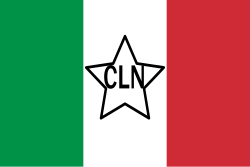You can help expand this article with text translated from the corresponding article in Italian. (February 2024)Click [show] for important translation instructions.
|
National Liberation Committee Comitato di Liberazione Nazionale | |
|---|---|
 | |
| President | Ivanoe Bonomi |
| Other leaders | |
| Founded | 8 September 1943 |
| Dissolved | 1 June 1947 [nb 1] |
| Headquarters | Rome, Italy |
| Ideology | Anti-fascism |
| Part of a series on |
| Anti-fascism |
|---|
 |
The National Liberation Committee (Italian : Comitato di Liberazione Nazionale, CLN) was a political umbrella organization and the main representative of the Italian resistance movement fighting against the occupying forces of Nazi Germany and the fascist collaborationist forces of the Italian Social Republic during the German occupation of Italy in the aftermath of the armistice of Cassibile, while simultaneously fighting against Italian fascists during the Italian Civil War. It coordinated and directed the Italian resistance and was subdivided into the Central Committee for National Liberation (CCLN), which was based in Rome, and the later National Liberation Committee for Northern Italy (CLNAI), which was based in Milan. The CNL was a multi-party entity, whose members were united by their anti-fascism. [2] [3]